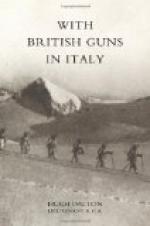Accordingly next morning at ten o’clock we started off again in the carrozza. We visited first San Martino della Battaglia, only a few miles from the southern end of the Lake. This was the northern extremity of the battlefield of Solferino. It was here that the Sardinians and Piedmontese, forming the left wing of the Franco-Italian Army, attacked and drove back the Austrian right wing. A memorial tower has been erected here, 250 feet high, with great avenues of cypresses radiating outwards from it. The custodian is a handsome boy, who lost a leg at the taking of Gorizia two years ago. There is no stair-case within the tower; one goes up by a spiral inclined plane. At successive stages, as one ascends, are large and detailed paintings, running right round the inner circumference of the tower, representing the battles of the Italian Wars of Liberation from 1848 to 1870. As works of art they are not of the first class, but they convey here and there a vivid sense of life and movement, an advance of the Bersaglieri with their cocks’ feathers waving in the wind, Garibaldini in their red shirts rushing Bomba’s gunners on the Volturno, Italian cavalry charging a Battalion of brown-coated Croats at Custozza, the defence of a fort in the Venetian lagoons against Austrian warships.
On a fine day the view from the top is very good, but that day it was hazy in the great heat. Close by is an Ossario, containing the skulls and bones of seven thousand dead collected in the neighbourhood, washed clean with white wine and set out in neat rows, the majority Italian. A good warning, one would think, against war, and more compact and less wasteful of space than a conventional graveyard.
Thence we drove on to Solferino, a little remote village with a single street paved with cobble stones, seldom visited by foreign tourists. The plaster on the walls of the farmhouses hereabouts still bears many bullet marks. As we drove, the Garibaldino pointed out to us some of the positions where Napoleon III.’s Generals had sited their Batteries. We were the first British officers seen here during the war, and had an enthusiastic reception. I was surprised to find that none of our Regulars had come over from Sirmione, as a matter of professional interest and duty, to study the tactics of 1859 upon the ground.




